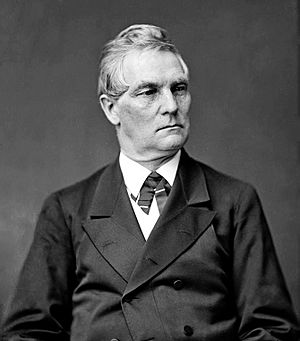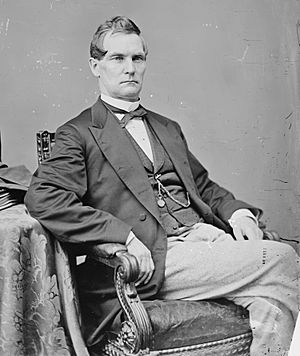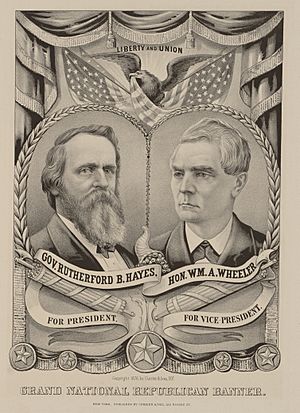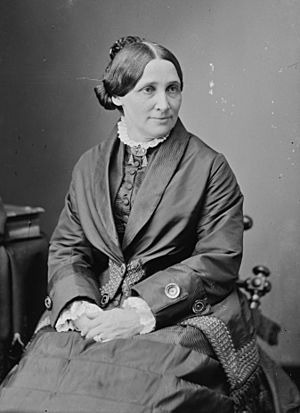William A. Wheeler facts for kids
Quick facts for kids
William A. Wheeler
|
|
|---|---|

Wheeler in 1877
|
|
| 19th Vice President of the United States | |
| In office March 4, 1877 – March 4, 1881 |
|
| President | Rutherford B. Hayes |
| Preceded by | Henry Wilson |
| Succeeded by | Chester A. Arthur |
| Member of the U.S. House of Representatives from New York |
|
| In office March 4, 1869 – March 3, 1877 |
|
| Preceded by | Calvin T. Hulburd |
| Succeeded by | Amaziah B. James |
| Constituency | 17th district (1869–73) 18th district (1873–75) 19th district (1875–77) |
| In office March 4, 1861 – March 3, 1863 |
|
| Preceded by | George Palmer |
| Succeeded by | Orlando Kellogg |
| Constituency | 16th district |
| Member of the New York Senate from the 17th district |
|
| In office January 1, 1858 – December 31, 1859 |
|
| Preceded by | Joseph H. Ramsey |
| Succeeded by | Charles C. Montgomery |
| Member of the New York State Assembly from the Franklin County district |
|
| In office January 1, 1850 – December 31, 1851 |
|
| Preceded by | George Gove |
| Succeeded by | Darius Lawrence |
| Personal details | |
| Born |
William Almon Wheeler
June 30, 1819 Malone, New York, U.S. |
| Died | June 4, 1887 (aged 67) Malone, New York, U.S. |
| Resting place | Morningside Cemetery, Malone, New York, U.S. |
| Political party | Whig Republican |
| Spouse |
Mary King
(m. 1845; |
| Education | University of Vermont (BA) |
| Profession | Attorney |
| Signature | |
William Almon Wheeler (June 30, 1819 – June 4, 1887) was an American politician and attorney. He served as a United States representative from New York from 1861 to 1863 and 1869 to 1877, and the 19th vice president of the United States from 1877 to 1881.
Born in Malone, New York, Wheeler pursued a legal career after attending the University of Vermont. After serving in various local positions, he won election to the New York State Legislature. He served in Congress from 1861 to 1863 and from 1869 to 1877. He was widely respected for his integrity and refused a salary increase after Congress passed an 1873 pay raise that he opposed.
After the 1876 Republican National Convention settled on Rutherford B. Hayes as the party's presidential nominee after seven ballots, the delegates nominated Wheeler for vice president. Nominated by Congressman Luke P. Poland, Wheeler surged into an early lead over Frederick T. Frelinghuysen, Marshall Jewell, and Stewart L. Woodford to clinch the nomination on the first ballot. Wheeler was nominated because he was popular among his colleagues and had worked to avoid making enemies in Congress. In addition, as a resident of the populous Eastern state of New York, he provided geographical balance to the ticket, since Hayes was from the populous Midwest state of Ohio. The Republican ticket prevailed in the contentious 1876 presidential election, though they lost the popular vote. Though they had not known each other before the convention, Wheeler and Hayes got along amicably while in office. They chose not to seek second terms, and Wheeler returned to Malone, New York, after the end of his term. He died in 1887 and was buried at Morningside Cemetery in Malone.
Wheeler's pursuit of an alliance between Republicans and Old Southern Whigs, which involved an abandonment of the Republican Party's commitment to ensuring civil rights and social equality, doomed Southern blacks to the hands of Democratic white supremacists, who enacted Jim Crow laws that lasted for decades.
Contents
Early life and career
William Almon Wheeler was born in Malone, New York, and attended Franklin Academy and the University of Vermont, although monetary concerns forced him to drop out without graduating. Wheeler received the honorary degrees of Master of Arts from Dartmouth College in 1865 and LL.D. from the University of Vermont (1867) and Union College (1877). In 1876, he received his Bachelor of Arts degree from the University of Vermont "as in course", making him a graduate of the class of 1842. In 1845, he married Mary King (1828–1876).
He studied law with Asa Hascall, a Malone attorney and politician who served as town supervisor, justice of the peace, district attorney, and member of the New York State Assembly. Wheeler was admitted to the bar in 1845, and practiced in Malone. He was District Attorney of Franklin County from 1846 to 1849. He was a member of the Assembly (Franklin County) in 1850 and 1851; and of the New York State Senate (17th D.) in 1858 and 1859.
He was elected as a Republican to the 37th United States Congress, holding office from March 4, 1861, to March 3, 1863. He was elected to the 41st, 42nd, 43rd and 44th United States Congresses, holding office from March 4, 1869, to March 3, 1877.
During his House tenure, Wheeler served as chairman of the Committee on Pacific Railroads (42nd Congress) and the Committee on Commerce (43rd Congress).
Wheeler's reputation for honesty was celebrated by Allan Nevins in his introduction to John F. Kennedy's Profiles in Courage. Roscoe Conkling, a Senator and New York State political boss, once offered, "Wheeler, if you will act with us, there is nothing in the gift of the State of New York to which you may not reasonably aspire." Wheeler declined with "Mr. Conkling, there is nothing in the gift of the State of New York which will compensate me for the forfeiture of my self-respect."
Wheeler served as president of New York's Northern Railroad. He was also president of the New York State Constitutional Convention which met from June 1867 to February 1868.
When Congress voted for a pay raise in 1873 and made it retroactive for five years (the Salary Grab Act), Wheeler not only voted against the raise but also returned his salary increase to the Treasury Department.
Wheeler was responsible for the so-called Wheeler Compromise of 1875, which settled a volatile political situation in Louisiana but eventually led to the withdrawal of federal troops and the end of Reconstruction.
Election of 1876
Wheeler was a delegate to the 1876 Republican National Convention, which had nominated Rutherford B. Hayes for president on the seventh ballot.
Wheeler was considered a "safe" choice for the vice presidential nomination, as he had not made many enemies over the course of his political career, though Roscoe Conkling himself supported the former congressman from New York, Stewart L. Woodford. When the time came for the convention to nominate a vice presidential candidate, congressman Luke P. Poland of Vermont nominated Wheeler, who immediately surged to the lead over Woodford and several other candidates. By the time the roll call reached New York, the result was apparent, and Woodford withdrew, enabling New York to cast all its votes for Wheeler. Wheeler won the nomination with 366 votes to the 89 for his nearest rival Frederick T. Frelinghuysen, who later served on the Electoral Commission which decided the 1876 election in favor of Hayes and Wheeler.
Governor Hayes, when he heard of Wheeler's nomination, wrote to his wife Lucy: "I am ashamed to say: Who is Wheeler?" Hayes and Wheeler had not served in the House of Representatives at the same time, so Hayes was unfamiliar with his running mate.
At the Republican National Convention, Frederick Douglass asked if the GOP would adhere to its pro-civil rights roots. The advocacy of Hayes and Wheeler, among a faction of Northern Republicans, was to abandon Reconstruction efforts and instead make conciliatory appeals to Southern Whiggery.
Vice presidency (1877–1881)
He was inaugurated on March 4, 1877 and served until March 4, 1881.
Since Wheeler was a recent widower, his wife having died one year before he took office, he was a frequent guest at the White House's alcohol-free luncheons. As vice president, Wheeler presided over the Senate. According to Hayes, Wheeler "was one of the few Vice Presidents who were on cordial terms, intimate and friendly, with the President. Our family were heartily fond of him."
Hayes had announced at the start of his administration that he would not run for a second term. Wheeler did not run for the 1880 Republican presidential nomination, and retired at the end of his term.
Lucy Hayes' Fishing Trip (1878)
When First Lady Lucy Webb Hayes found out about Wheeler's status as a widower without children, she and her husband felt it was their duty to take the lonely Wheeler into their social circle. Wheeler was grateful for their kindness, and during the spring of 1878, he asked Lucy to accompany him on a fishing trip in the Adirondacks. Lucy accepted and joined Wheeler on May 31st. On their first day, they caught a large trout that weighed about 13 pounds. Wheeler sent it to the president; Hayes telegraphed jokingly that he thought it was more like 13 ounces. Hayes was actually surprised at the size of the fish, and had it served at an informal dinner with cabinet members and senators. The next day, Wheeler and Lucy were traveling back to Malone when a group of children began waving red flags. Touched by the act, Wheeler stopped their carriage so he could introduce the first lady to the children. The trip lasted eleven days, and when Lucy and her daughter Fanny returned to Washington, she wrote to Wheeler to thank him for "a wild and joyous time".
Post-vice presidency (1881–1887)
In January 1881, Wheeler received 10 votes in the New York State Legislature's Republican caucus to determine a nominee for the U.S. Senate seat held by Democrat Francis Kernan. The Republican nomination went to Thomas C. Platt, who received 54 caucus votes. The Republicans controlled the legislature, and Platt defeated Kernan 104 votes to 50.
Wheeler retired to Malone following the end of his vice presidential term on March 4, 1881. In May 1881, Platt and Roscoe Conkling resigned their U.S. Senate seats in a dispute with President James A. Garfield over control of patronage in New York, triggering two special elections. In the legislative election for Platt's seat, it took six weeks of balloting to elect a candidate. Wheeler's name was in consideration, and he received as many as 23 votes before Warner Miller was elected with 76 votes on the 46th ballot.
Wheeler was also a candidate for Conkling's seat. The voting went on for several weeks and Wheeler received as many as 50 votes on some ballots before Elbridge G. Lapham won with 92 votes on the 56th ballot.
Wheeler suffered from several illnesses throughout his life and was in increasingly poor health during his later years. He died at his home at 10:10 a.m. on Saturday, June 4, 1887. The funeral was held at the Congregational church in Malone. He was interred next to his wife in Malone's Morningside Cemetery on June 7, 1887.
See also
 In Spanish: William A. Wheeler para niños
In Spanish: William A. Wheeler para niños





